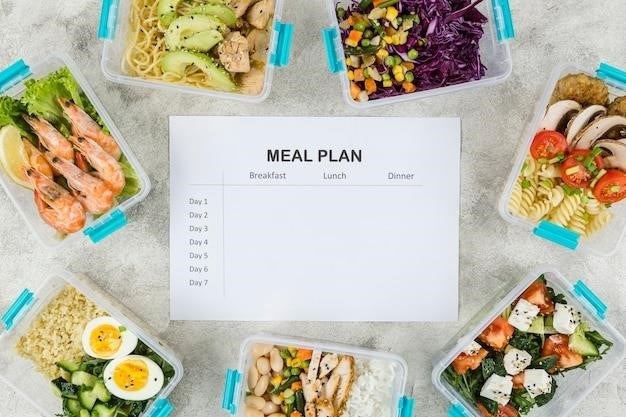Semaglutide Meal Plan PDF⁚ A Comprehensive Guide
This comprehensive guide provides a detailed overview of semaglutide and the importance of a tailored meal plan for optimal results. You’ll discover the benefits of a semaglutide meal plan, key principles to follow, and sample meal plans. It also covers essential tips, considerations for meal timing, the role of exercise, and frequently asked questions.
Introduction
Semaglutide, a medication increasingly popular for its weight loss benefits, is a glucagon-like peptide-1 (GLP-1) receptor agonist. It mimics the effects of naturally occurring incretin hormones, which are released after meals and play a crucial role in regulating blood sugar levels and appetite. Semaglutide’s ability to suppress appetite and promote feelings of fullness makes it a valuable tool for weight management. However, maximizing its effectiveness requires a well-structured meal plan that complements the medication’s action.
This comprehensive guide explores the significance of a semaglutide meal plan, delving into its benefits, key principles, and practical tips. We’ll guide you through creating a personalized eating plan that aligns with your individual needs and goals. Whether you’re seeking to lose weight, manage type 2 diabetes, or simply improve your overall health, this guide provides the essential information to make informed decisions about your nutrition while on semaglutide.
Understanding Semaglutide
Semaglutide is a medication that belongs to a class of drugs called glucagon-like peptide-1 (GLP-1) receptor agonists. These medications work by mimicking the effects of a naturally occurring hormone called GLP-1, which is released in the gut after meals. GLP-1 plays a crucial role in regulating blood sugar levels and appetite. It slows down the emptying of the stomach, promoting feelings of fullness and reducing hunger signals. Semaglutide’s mechanism of action makes it a valuable tool for both managing type 2 diabetes and facilitating weight loss.
When taken as prescribed, semaglutide can effectively manage blood sugar levels in patients with type 2 diabetes. Its ability to suppress appetite and promote a sense of fullness makes it particularly beneficial for individuals seeking to lose weight. However, it’s important to understand that semaglutide is not a magic bullet. It works best when combined with lifestyle modifications, including a healthy diet and regular exercise. This is where a tailored meal plan becomes essential.
Why a Meal Plan is Essential
While semaglutide can significantly reduce appetite and promote feelings of fullness, it’s not a substitute for a healthy diet. A well-structured meal plan is crucial for maximizing the benefits of semaglutide and achieving sustainable weight loss. A meal plan provides a framework for making informed food choices, ensuring you’re consuming adequate nutrients while managing your calorie intake effectively.
A meal plan tailored to your individual needs and goals can help you navigate the changes in your appetite and eating patterns while on semaglutide. It can guide you towards consuming nutrient-dense foods that support your overall health and well-being. Moreover, a meal plan can provide a sense of structure and predictability, helping you avoid impulsive food choices and prevent overeating, which can be particularly challenging when your appetite is suppressed.
Ultimately, a meal plan is an essential tool for optimizing your weight loss journey while on semaglutide. It helps you make informed food choices, manage your calorie intake, and ensure you’re getting the necessary nutrients for optimal health.

Benefits of a Semaglutide Meal Plan
A tailored semaglutide meal plan offers numerous benefits that contribute to successful weight management and overall well-being. By providing a structured approach to eating, a meal plan can help you make healthier food choices, manage your calorie intake effectively, and ensure you’re getting essential nutrients. This, in turn, can lead to significant weight loss, improved blood sugar control, and reduced risk of developing type 2 diabetes.
A semaglutide meal plan can also help you develop healthier eating habits that can be sustained even after you stop taking the medication. By focusing on whole foods, lean proteins, and complex carbohydrates, you’ll learn to appreciate the flavors and satiety of nutrient-rich foods. This shift in your dietary patterns can have a lasting positive impact on your health and relationship with food.
Furthermore, a meal plan can provide a sense of structure and accountability, empowering you to take control of your weight loss journey. It can help you avoid impulsive food choices, manage cravings, and track your progress towards your goals. The benefits of a semaglutide meal plan extend beyond weight loss, contributing to a healthier and more fulfilling lifestyle.
Key Principles of a Semaglutide Meal Plan
A semaglutide meal plan revolves around key principles that promote healthy weight loss and overall well-being. The emphasis is on consuming nutrient-rich foods that provide sustained energy, manage blood sugar levels, and support satiety. These principles guide the creation of a balanced diet that complements the effects of semaglutide and helps you achieve your weight loss goals.
The fundamental principles of a semaglutide meal plan include prioritizing lean protein, embracing complex carbohydrates, loading up on fruits and vegetables, and incorporating healthy fats. These food choices provide essential nutrients, support a feeling of fullness, and contribute to a balanced diet that aligns with the medication’s effects. By adhering to these principles, you can create a personalized meal plan that supports your individual needs and preferences.
It’s important to note that these principles are not rigid rules but rather guidelines to help you make informed choices about your diet. Consulting with a registered dietitian or healthcare professional can provide personalized guidance and ensure that your meal plan is tailored to your specific health conditions and goals.
Prioritize Lean Protein
Incorporating lean protein into every meal is a cornerstone of a successful semaglutide meal plan. Lean protein plays a crucial role in promoting satiety, managing blood sugar levels, and supporting muscle mass. By prioritizing protein, you can effectively curb cravings, reduce hunger pangs, and maintain energy throughout the day.
Lean protein sources are rich in essential amino acids, which are vital for building and repairing tissues, producing hormones, and supporting various bodily functions. These sources are generally lower in fat and calories compared to their fattier counterparts, making them a healthier choice for weight management.
Examples of lean protein sources include skinless chicken breast, white fish, lean beef, tofu, beans, lentils, nuts, and seeds. These versatile ingredients can be incorporated into a wide range of meals and snacks, ensuring you get an adequate protein intake without compromising flavor or variety.
Embrace Complex Carbohydrates
Complex carbohydrates, also known as whole grains, are an integral part of a balanced semaglutide meal plan. Unlike simple carbohydrates, which are quickly digested and cause rapid blood sugar spikes, complex carbohydrates provide a sustained release of energy, promoting a feeling of fullness and helping to regulate blood sugar levels. This can help prevent the energy crashes and cravings that often accompany simple carbohydrate intake.
Whole grains are packed with fiber, which is essential for digestive health and plays a significant role in weight management. Fiber adds bulk to your meals, making you feel fuller for longer and reducing the urge to overeat. It also helps slow down the absorption of sugar into the bloodstream, contributing to better blood sugar control.
Good sources of complex carbohydrates include brown rice, quinoa, oats, whole-wheat bread, and whole-grain pasta. By choosing these options over refined grains, you can enjoy the benefits of complex carbohydrates while supporting overall health and well-being.
Load Up on Fruits and Vegetables
Fruits and vegetables are essential components of a healthy diet, and their importance is amplified when you’re on semaglutide. They are naturally low in calories and high in essential vitamins, minerals, and fiber, all of which contribute to weight management and overall well-being.
Fruits and vegetables are rich in antioxidants, which help protect your body from damage caused by free radicals. These free radicals contribute to aging and various health problems. By loading up on fruits and vegetables, you’re providing your body with a powerful defense against these harmful substances.
Fruits and vegetables are also excellent sources of fiber, which promotes a sense of fullness and helps regulate blood sugar levels. They can help you feel satisfied after meals, reducing the urge to snack between meals and supporting your weight loss goals. Aim for at least five servings of fruits and vegetables per day, incorporating a variety of colors and types to maximize their nutritional benefits.
Incorporate Healthy Fats
Contrary to popular belief, healthy fats are an essential part of a balanced diet, even when you’re on semaglutide. They play a vital role in hormone production, cell function, and absorption of essential nutrients. However, it’s crucial to choose healthy fats over unhealthy ones.
Opt for unsaturated fats found in sources like olive oil, avocado, nuts, and fatty fish. These fats can help lower bad cholesterol (LDL) and increase good cholesterol (HDL), contributing to heart health. They also provide a feeling of satiety, helping you feel fuller for longer, which can be particularly beneficial when you’re on semaglutide.
Avoid saturated and trans fats, often found in processed foods, fried foods, and baked goods. These fats can raise LDL cholesterol levels and increase the risk of heart disease. By making smart choices and incorporating healthy fats into your diet, you’re not only supporting your weight loss journey but also promoting overall health and well-being.
Sample Semaglutide Meal Plan
Here’s a sample semaglutide meal plan for a typical day. Remember, this is just a guide, and you should work with a healthcare professional or registered dietitian to create a meal plan that suits your individual needs and preferences.
Breakfast⁚ Greek yogurt with berries and a sprinkle of chia seeds, or an omelet with spinach, mushrooms, and a small amount of low-fat cheese.
Lunch⁚ Grilled salmon with roasted vegetables (like broccoli, asparagus, or bell peppers) and a side of quinoa.
Dinner⁚ Chicken stir-fry with brown rice, tofu, and plenty of vegetables like snap peas, carrots, and onions.
Snacks⁚ A handful of almonds, a piece of fruit, or a low-fat Greek yogurt.
Remember to prioritize lean protein, complex carbohydrates, fruits, and vegetables. Stay hydrated throughout the day by drinking plenty of water. You can adjust this sample meal plan to fit your individual needs and preferences.
Tips for Meal Planning
Meal planning is essential for success on a semaglutide journey. Here are some tips to make it easier⁚
- Plan ahead⁚ Dedicate some time each week to plan your meals and snacks. This helps prevent impulsive choices and ensures you have healthy options readily available.
- Cook in bulk⁚ Prepare large batches of meals to freeze for later. This saves time and effort during busy weeks.
- Pack snacks⁚ Always have healthy snacks on hand to avoid hunger pangs and unhealthy choices.
- Read labels⁚ Pay attention to serving sizes and calorie counts when choosing pre-packaged foods.
- Be mindful of portion sizes⁚ Semaglutide can reduce your appetite, but it’s still essential to be mindful of portion sizes.
- Incorporate variety⁚ Choose a wide range of foods to prevent boredom and ensure you’re getting a variety of nutrients.
- Listen to your body⁚ Pay attention to your hunger cues and eat when you’re truly hungry, not just out of habit or boredom.
Remember, consistency and mindful eating are key to maximizing the benefits of semaglutide.
Considerations for Meal Timing
Meal timing plays a significant role in optimizing semaglutide’s effectiveness. Here’s what to consider⁚
- Intermittent Fasting⁚ Some individuals find that intermittent fasting, such as the 16/8 method, complements semaglutide well. This involves restricting eating to a specific window each day, often for 8 hours, and fasting for the remaining 16 hours. It can help regulate hunger and boost weight loss.
- Spacing Meals⁚ Avoid skipping meals, as this can lead to excessive hunger and potentially hinder weight loss. Aim to consume meals throughout the day, spacing them out to maintain steady blood sugar levels.
- Pre-Meal Protein⁚ Some experts recommend consuming a source of lean protein before meals to help increase satiety and minimize overeating. This can be as simple as a small handful of nuts, a slice of turkey, or a protein shake.
- Hydration⁚ Drink plenty of water throughout the day, especially before meals. This can help you feel fuller and may reduce your overall calorie intake.
It’s important to consult with your doctor or a registered dietitian to determine the best meal timing strategy for your individual needs and goals.
Semaglutide and Exercise
While semaglutide can aid in weight loss, it’s crucial to remember that it’s not a magic bullet. A healthy lifestyle, including regular exercise, plays a vital role in maximizing its benefits and promoting long-term success. Here’s why exercise is essential when taking semaglutide⁚
- Enhanced Weight Loss⁚ Combining semaglutide with a consistent exercise routine can significantly boost weight loss results. Exercise helps burn calories, build muscle mass, and improve overall metabolism.
- Improved Blood Sugar Control⁚ Exercise helps regulate blood sugar levels, which is particularly important for individuals with type 2 diabetes.
- Increased Energy Levels⁚ Regular physical activity can combat fatigue and increase energy levels, which can be beneficial for those on semaglutide.
- Reduced Risk of Chronic Diseases⁚ Exercise is a cornerstone of preventing and managing chronic diseases like heart disease, stroke, and certain types of cancer.
Consult with your doctor or a certified personal trainer to determine a safe and effective exercise plan that aligns with your individual fitness level and health status.
FAQs
Here are some common questions about semaglutide meal plans⁚
- What diet is best while taking semaglutide? There isn’t a specific “Ozempic Diet,” but it’s generally recommended to focus on a balanced diet rich in lean protein, whole grains, fruits, vegetables, and healthy fats.
- How many calories should I eat while on semaglutide? The calorie intake for semaglutide patients typically ranges between 1,000 and 1,800 calories per day, but it’s essential to consult with a healthcare professional to determine a personalized plan.
- How to maximize weight loss on semaglutide? Combining semaglutide with a healthy diet, regular exercise, and sufficient sleep can significantly enhance weight loss results.
- How fast can I lose 20 lbs on semaglutide? The rate of weight loss varies depending on individual factors, but you might expect to lose 20 lbs in 4-5 months.
For personalized advice and guidance, it’s always best to consult with a healthcare professional or a registered dietitian.
A semaglutide meal plan is a valuable tool for achieving optimal weight loss and managing blood sugar levels. By understanding the principles of a balanced diet, incorporating lean proteins, complex carbohydrates, fruits, vegetables, and healthy fats, you can create a personalized meal plan that supports your overall health and well-being. Remember, consistency is key, and it’s essential to consult with a healthcare professional or a registered dietitian for tailored guidance. With a well-structured meal plan, you can effectively manage your weight, improve your health, and achieve your weight loss goals while on semaglutide.
This guide provides a foundation for creating a successful semaglutide meal plan. By incorporating the information provided and seeking professional advice, you can embark on a journey towards a healthier and more fulfilling lifestyle.


